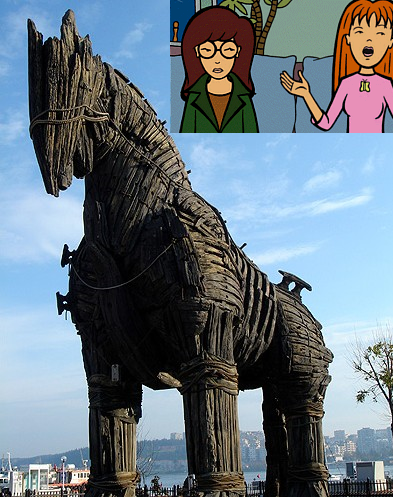Mythconception #1 (Greek): The Trojan Horse is in the Iliad.
Even Daria fell for this one, in the episode when she tried to get her younger sister to read the Iliad:
DARIA: Try this. I think you’ll get into it.
QUINN: Ha, ha, very funny. Now give me something that I can read.
DARIA: No, I think you’ll like it. It’s about this girl who’s so popular that everybody fights over her.
QUINN: Any horses in it?
DARIA: As a matter of a fact, there’s a great big one.
QUINN: This is a trick, isn’t it?
DARIA: Yes.

But in fact the Iliad isn’t an account of the entire Trojan War; it starts nine years after the beginning of hostilities, and ends while the war is still going on – too soon to include the Trojan Horse. (The horse does get a brief mention in Homer – but in the Odyssey, not the Iliad; our fullest info on the Horse comes from such post-Homeric sources as Triphiodorus, Vergil, and Quintus of Smyrna.)
Mythconception #2 (Norse): All heroic Viking warriors slain in battle go to Valhalla.
Nope. Only half go to Valhalla; the other half go to a lesser-known – but apparently equally desirable – hall called Sessrúmnir (“many-seated”) in Fólkvangr (“field of warriors”), presided over by the goddess Freyja. The principle of selection is unclear.

Mythconception #3 (Hebrew): Noah took two of each kind of animal onto the ark.
Not according to Genesis. True, God does initially tell Noah to bring two of each kind (Gen. 6: 19-20), but God soon goes on to clarify that Noah should actually take seven of each kosher animal, and two only of the non-kosher ones (Gen. 7: 2-3). (I guess this answers the question of what Noah and his family ate while they were in the ark.) [Updated: I am an idiot. Of course that should be seven pairs of each kosher animal – though now I wonder whether he was also supposed to take two pairs for the non-kosher ones.]

To be sure, the Genesis account appears to have been put together from at least two different sources, one of which simply says two of each kind and calls God Elohim, while the other offers the seven-kosher-and-two-not rule and calls God Yahweh; but in Genesis as we have it, the final word seems to be seven-kosher-and-two-not.
Mythconception #4 (Hindu): Once Rama rescues his kidnapped wife, they live happily ever after.
Not so much. Because Sita has been living in another man’s house, the presumption is that she has been unfaithful to her husband. Rama knows this presumption to be false, but as a king he values public opinion more than he values Sita – Caesar’s wife must be above suspicion, so to speak – and so, despite having spent the entire massive epic trying to get his wife back, once he does so he sends her into exile. It’s as though Odysseus had showed up on Ithaca and said to Penelope: “Hi honey, I’m home. Love ya. Now get off my island.”

Mythconception #5 (Celtic): The sword in the stone was named Excalibur.
Monty Python sadly leads us astray here:
OLD WOMAN: Well, how’d you become king, then?
ARTHUR: The Lady of the Lake, her arm clad in the purest shimmering samite, held aloft Excalibur from the bosom of the water, signifying by Divine Providence that I, Arthur, was to carry Excalibur. That is why I am your king!
DENNIS: Listen, strange women lying in ponds distributing swords is no basis for a system of government. Supreme executive power derives from a mandate from the masses, not from some farcical aquatic ceremony. … You can’t expect to wield supreme executive power just ’cause some watery tart threw a sword at you! … I mean, if I went around saying I was an emperor just because some moistened bint had lobbed a scimitar at me, they’d put me away!

But at least in most of the earliest versions of the story, these are two different swords: the sword that Arthur drew forth from the stone to establish his legitimate claim to the throne was never named, while Excalibur was a different sword that Arthur got from the Lady of the Lake after he was already king.
That’s such a delightful story that it really ought to be true; but here’s what Smith himself says about it: